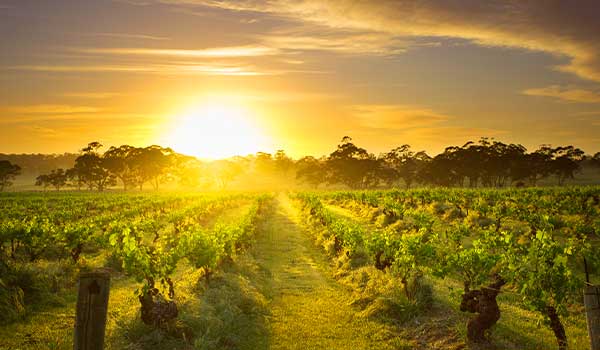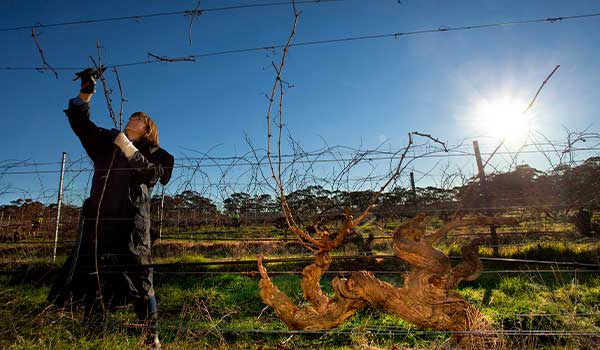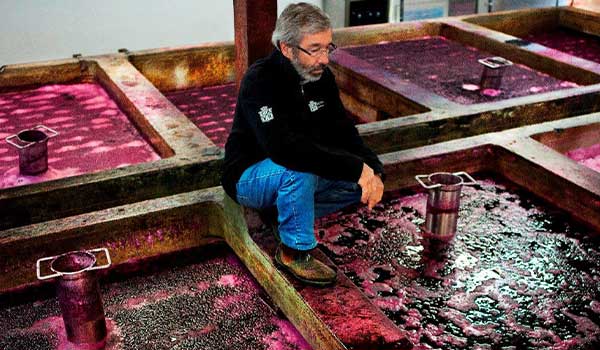The story of Mount Edelstone and Australia’s first single vineyard wine
It’s a question wine aficionado’s could spend days, weeks and months arguing over. What is Australia’s greatest vineyard? Several lauded names jump straight to the top of the discussion. Hill of Grace. Wendouree. Old Hill. 4 Acres. Mount Mary. Each vineyard steeped in history and folklore. Each producing wines draped in medals, trophies and the loftiest of scores. Wines desired by collectors who understand the importance of site and sympathetic craft in producing wines of the highest calibre.
There is one very important name that may get missed in this discussion. Missed because it doesn’t have a storied history? Missed because the wines lack the quality to compare? The answer to these questions is absolutely and definitively no. One of Australia’s greatest vineyards may fall down the pecking order, but only because it’s older relative, Hill of Grace, tends to rightfully dominate the conversation. This fabled vineyard could be just one of the Henschke family’s suite of exceptional vineyards. But it’s not. It’s one of the most important patches of dirt planted to vines in the history of Australian wine. Mount Edelstone. To celebrate the release of the stunning 2018 iteration from these centenarian vines wine writer Ben Moroney takes a look at what makes Mount Edelstone important and why it’s an essential part of any Australian wine collection.
..If Hill of Grace is Australia’s most significant single vineyard wine, Mount Edelstone too would be top ten, if not top five...
Campbell Mattinson

Golden hour at the Mount Edelstone vineyard, Eden Valley (Dragan Radocaj
The story of the Henschke family, one of Australia’s First Families of Wine, is a tale of passion, determination and innovation that rivals Penfolds for impact on the Australian fine wine paradigm. Johann Christian Henschke travelled with his family from Silesia to the burgeoning colony of South Australia in 1841. Following tragedy at sea, a story for another day, Johann purchased land in the Eden Valley town of Keyneton in 1862. Here Johann put his skills as a mason to good use, building a small two-storey cellar into the side of a hill on the property, setting in motion a series of events that would lead to one of the world’s great wine dynasties.
Second generation Paul Gotthard Henschke took Johann’s foundations, which included the astute purchase of the Hill of Grace vineyard near the Gnadenberg Church, and built on them. He expanded the winery, installing brick and cement fermentation vats and underground storage tanks. Paul’s son, Paul Alfred Henschke, took over the winery, farm and homestead in 1914 after Paul Gotthard’s passing. Paul soon expanded the vineyard holdings and showed the now trademark Henschke determination by continuing to produce dry red and white wines when fortifieds were de rigueur at the time. His youngest son, Cyril Alfred Henschke, was fascinated by wine from a young age and so was the perfect choice to further develop the family business.
This wine is made from shiraz grapes grown at Mount Edelstone Vineyard, Keyneton.
Cyril Henschke started working as a winemaker at the age of 15 at Hardy’s Siegersdorf winery, building on the knowledge he’d gained growing up around the winery. Like his father before him, Cyril had a passion for dry table wines, even if the market was miniscule at the time. He shared this passion with other legendary names such as Maurice O’Shea, Colin Preece and Max Schubert but it could be argued that Cyril was the most forward-thinking and innovative of them all. He made single varietal wines from riesling and semillon. He identified Eden Valley as being a place that could grow truly exceptional riesling and shiraz. And in 1952 he simply labelled an Eden Valley shiraz as Mount Edelstone Claret bottled by C A Henschke & Co, North Rhine Winery, Keyneton, South Australia. The back label read, “This wine is made from shiraz grapes grown at Mount Edelstone Vineyard, Keyneton.” A simple label that started a revolution.
Today you’ll struggle to find a winery website anywhere in the world that doesn’t talk about terroir, sense of place and how important it is to reflect the flavours of the vineyard in a fine wine. Australian wine collectors rightly scour the country for unique expressions of soil, season and sympathetic craftsmanship. Today Australia’s best vineyards are lauded across the globe, respected for expressing the beauty and the character of a single site. Cyril Alfred Henschke was passionate about giving wine lover’s a glimpse into the history of a vineyard, telling the story of the unique patch of land and people that make these truly special wines. In 1952. There’s no doubt the Henschke’s are a determined and innovative bunch!
It didn’t take long for the world to see that Mount Edelstone vineyard was a special place. The 1956 vintage of the wine swept all before it on the national wine show circuit, and before long it was recognised as one of Australia’s greatest wines. This vineyard sits at 400 metres above sea level, and the ancient 500-million-year-old geology gives soils that are deep red-brown clay-loam to clay. This combination results in low yields from dry-grown, ungrafted vines, which are now over 110 years old. These venerable old vines are cared for by one of Australia’s greatest viticulturists, Prue Henschke, who has continued the family tradition of innovation.
Keeping the longevity in the vineyard is really the main task… I’ve done a lot of work to look after the soil condition… Going to organics and biodynamics has helped this… We retain a lot more moisture in the soil and we’re looking after the microflora. It’s keeping that soil really healthy.
Prue Henschke

Prue Henshcke pruning the vines at Mount Edelstone (Dragan Radocaj)
Organics and biodynamics have become buzzwords in the wine world in the last decade or so, with many falling over themselves to preach their sustainability credentials. Prue has been incorporating organic and biodynamic principles since the late 1980s to improve vine health and ensure the longevity of a priceless vine resource. The trellising of the vines was converted in 1989 from traditional hanging canopy to Scott Henry to improve light exposure. The results? Healthier vines have given fifth generation winemaker Stephen Henscke fruit which expresses significantly enhanced colour, aroma, flavour and tannin maturity. Important as the winemaking methods at Henschke have changed very little during the more than 110 year lifespan of the Mount Edelstone vineyard. Cooler ferments, pure culture yeast and increased use of French oak maturation complement the same traditional submerged cap open fermentation technique used when Paul Alfred Henschke ran the family business.

Stephen Henschke and the traditional open fermenters at the winery (Dragan Radocaj)
Today Henschke’s Classified Mount Edelstone Shiraz is one of Australia’s most sought after fine wines, one of our greatest wines from one of our greatest vineyards. The most recent release, the 2018 vintage of Mount Edelstone is on track to be considered a standout of the decade. This is a wine of wonderful richness, depth and balance. A wine that expressives a true sense of place with fine and mature tannins. The Henschke family have likened it to exceptional-quality vintages such as 1982, 1990, 2002 and 2010, all mild seasons that have proven to be excellent ageing prospects in ideal cellaring conditions. A wine that lives up to the hype, a wine that Cyril Henschke would be proud to call his own. Do what you can to get your hands on a bottle, gather your nearest and dearest. Raise a glass to Cyril, and the Henschke family. “This wine is made from shiraz grapes grown at Mount Edelstone Vineyard, Keyneton.”


